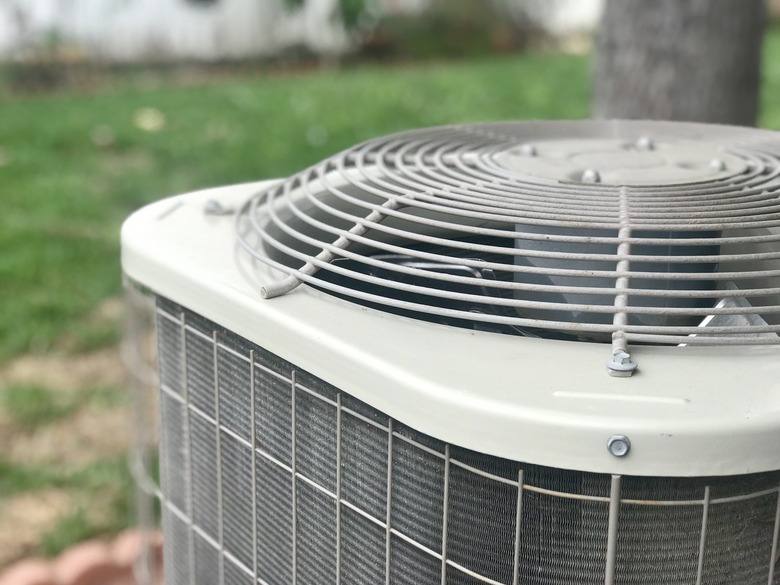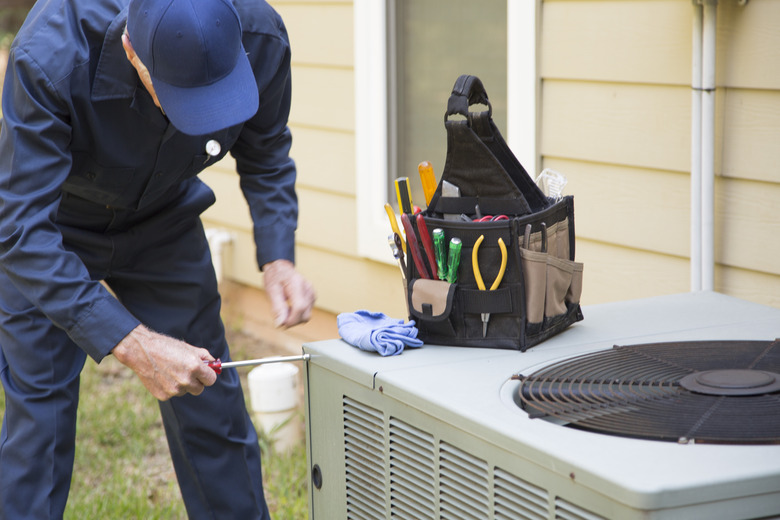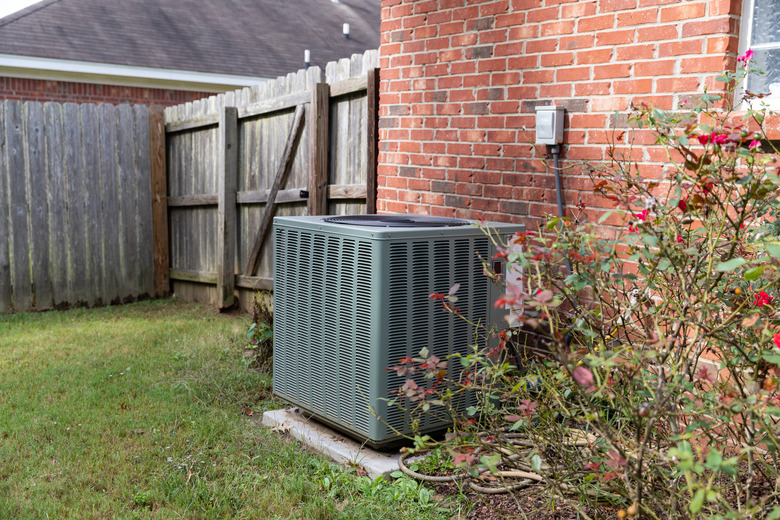5 Central Air Conditioner Problems — And How To Troubleshoot Them
Central air conditioner problems can be caused by improper installation, poor service procedures, or insufficient maintenance, but the leading cause of central A/C woes is actually improper operation. Some of the most common culprits include user error on programmable thermostats and loose access doors on the air handler or outdoor unit. Another major A/C usage faux pas is keeping the doors and windows open while the system is running (yes, your dad was unfortunately right).
Homeowners with a basic knowledge of how their A/C system works and an understanding of the thermostat functions can handle many of these issues on their own, and in many cases, the fixes are simple. It's often just a matter of reprogramming the thermostat, resetting a switch, or doing a deep clean.
Having A/C issues? Here are five common problems you may run across — and some guidance on how to fix them.
1. The Air Conditioner Won't Turn On
1. The Air Conditioner Won't Turn On
If an air conditioning system doesn't have power, you won't hear the blower motor, and when you check the outdoor unit, you won't hear the hum of the condenser. Chances are good that you'll be able to rectify the problem by running through this checklist:
- Check the thermostat: Make sure the thermostat isn't set to "off" or "heat," and if it is, switch it to "cool." Using the thermostat manual as a guide, set the target temperature to its minimum and if the system then switches on, reprogram the temperature. If the system still doesn't come on automatically, disable all time schedule programming and reset it only after the system comes on, and you're sure it's working.
- Look for tripped switches: There may be a tripped circuit breaker or a blown fuse in the main electrical panel, and if so, reset or replace it. You should also reset any switches that have tripped in the air handler or outdoor unit. Some units have a switch that trips if the condensate drain pan in the bottom of the air handler is full, so empty the drain pan and reset the switch. There's also an external safety switch in the back of the compressor housing outdoors; reset this if it has tripped.
- Close all doors: Many A/C units have door sensors that switch off the system if the door is open. Make sure the doors on both the air handler and the condensing unit are firmly closed.
2. The System Blows Warm Air
2. The System Blows Warm Air
A refrigerant leak can be the reason your air conditioning unit isn't blowing cold air, and that's something that can only be fixed by a licensed HVAC technician. If that's really the problem, there may be additional related problems, such as corroded piping or poor seals in the compressor, so the repair may be more complicated than simply recharging the system. The technician will conduct a detailed inspection and advise you of the extent of the damage. It could be expensive, so before you make the service call, ensure that's really the problem by doing these things to improve the performance of your system:
- Replace the air filter: The air handler inside the house has an air filter; if you have a furnace, this is the furnace filter. It should be changed at least quarterly if not monthly. Without good airflow in the air handler, insufficient air circulates around the evaporator coil (where cooling happens), and into the ductwork. The blower motor can overheat and compound the problem.
- Clean the compressor housing: Because it's outside, the compressor housing can get blocked by leaves and other debris. Clean off the housing regularly.
- Double-check the thermostat: The thermostat target temperature may not be properly set, or the thermostat itself may not be working properly. If you suspect a thermostat malfunction, you can try to fix it yourself, call for service, or just go ahead and replace it.
- The evaporator coil has frozen: When the filters aren't replaced as often as they should be, the lack of air circulation can cause the condensation on the evaporator coil to freeze, and the ice insulates the coil from the air circulating past it. Melt the ice by running the system in fan mode. Don't try to de-ice a frozen evaporator coil with a hard object as it's fragile and easily damaged.
3. The System Doesn't Blow Enough Air
3. The System Doesn't Blow Enough Air
Insufficient airflow from the registers in the house could signify a problem with the blower, but it's most often caused by a dirty air filter. If the blower is making strange sounds, have it serviced by a technician. However, if the blower is working normally and you've cleaned or replaced the air filters, do the following:
- Check the ductwork: Look for damaged joints, holes, or other places in exposed ductwork through which air can escape. A simple way to do this is to turn on the system and then hold a tissue paper over suspected leaks. If the paper waves, patch the seam of the hole with aluminum tape. If ducts are separating or you suspect a leak behind a wall where you have no access, your best bet is to call for service.
- Open the dampers: Dampers are revolving plates inside the ductwork that regulate airflow, and each one usually has a handle on the outside of the duct. Turn this handle to the horizontal position to completely open the damper. Each register also has its own damper, so make sure they are all fully open.
4. The Indoor Air Feels Humid and Clammy
4. The Indoor Air Feels Humid and Clammy
When a central air conditioner is working properly, it dehumidifies the air as well as cools it. If the A/C unit is circulating cool air but you're feeling clammy, it could be a refrigerant leak. Before you call for service, do some A/C troubleshooting on your own:
- Service the air filters and clean the outdoor unit housing.
- De-ice the evaporator coil if it has frozen.
5. The Air Conditioner Is Noisy
5. The Air Conditioner Is Noisy
You may hear strange noises from either the air handler or the outdoor unit, and that means there is a problem. There could be numerous causes:
- A loud, squealing sound could mean a loose belt either on the blower motor or the condenser fan motor. Suspect this if you have an older unit. You can often tighten the belt yourself by loosening a nut on the motor, adjusting it to tighten the belt, and retightening the nut, but if the belt appears cracked, it's best to remove and replace it. Newer models usually have a direct-drive mechanism instead of belts, and a squealing sound indicates a problem with the motor bearings. Fixing this is a job for an HVAC technician.
- A hissing sound in either the indoor or outdoor unit usually signifies a refrigerant leak from the evaporator coil, the condenser coil, or somewhere else. Call for service as soon as possible because the A/C unit won't produce cold air for long, assuming it's still producing any.
- A thumping or buzzing sound from the outdoor unit probably means the compressor has slipped off its isolation footings. Call for service if you can't lift the compressor yourself and set it back on its footings or if the footings are damaged and need to be replaced.
References
- Homesense Heating and Cooling: AC Troubleshooting: Fixing the Top 3 Issues
- Energy.gov: Common Air Conditioner Problems
- Arista: Air Conditioning Troubleshooting: 9 Common Problems & Solutions
- White Mechanical: 10 Common Air Conditioning Problems You Should Know About
- Air Experts: Why Is My Air Conditioner Making a Weird Noise?


